Ultrabook Head to Head: Acer Aspire S3 vs. ASUS UX31E
by Jarred Walton & Manveer Wasson on December 21, 2011 5:40 AM ESTAnd Then We Get to the LCDs…
Sadly, as much as some areas of the laptops are improved over other offerings, the displays in general are nothing to get excited about. The Acer LCD is a bog standard model while the ASUS goes for a higher HD+ resolution and one of the brightest backlights we’ve tested on a laptop; unfortunately, contrast ratio along with color quality and gamut are all in the dumps. Let’s not dwell on it too much before we see the charts.
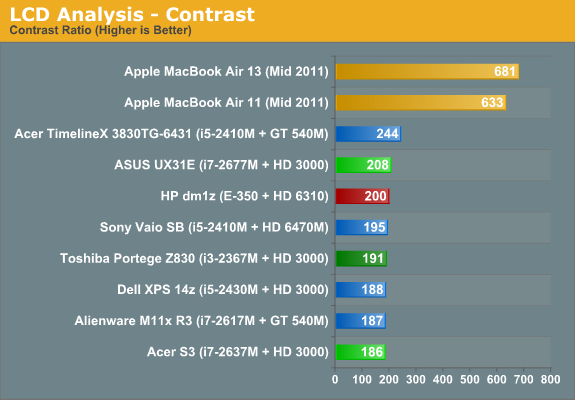
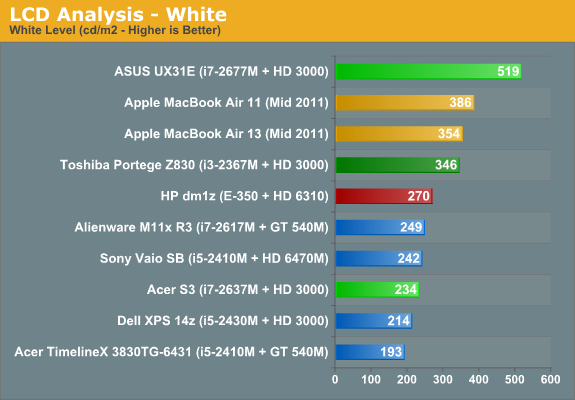
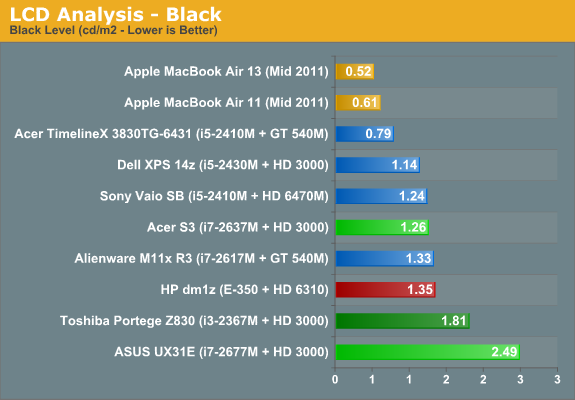
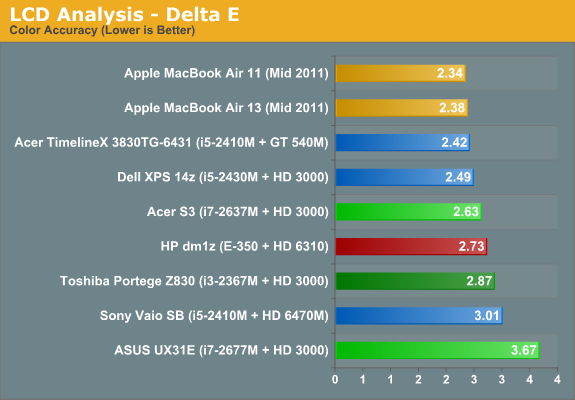
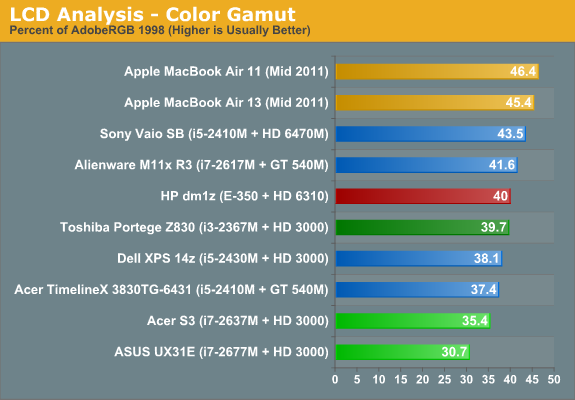
Of the laptops we’ve reviewed recently, the UX31E has the brightest LCD by far…along with the highest black level by far. The result is a contrast ratio that places near the top of our selection of eight mediocre displays. The Acer S3 on the other hand has middling white and black levels but the lowest contrast of the eight tested laptops. Continue on to color accuracy and gamut and things go from middling to lousy. The ASUS’ incredibly bright backlight results in very poor post-calibration Delta E of 3.67, with some colors in the double digits. Turn to the color gamut and we find part of the reason for that: the gamuts of both these ultrabooks are very poor, which means several of the test color patches are outside of their color range.
Viewing angles are typical of TN panels, with the vertical shots showing major color shifts. The ASUS panel does a lot better than the Acer, though neither one is great. We’ve got excellent 10.1” IPS panels now shipping in $400 tablets; why can’t we get a similar panel in 13.3” trim in a $1200 laptop? I’m probably preaching to the choir, but seriously: first IPS panel in a 13.3” laptop for under $1000 gets an Editor’s Choice award (as long as the rest of the laptop doesn’t completely suck).
In the grand scheme of things, though, how much do the LCD test results really matter? That’s a more difficult question to answer. Some users will never know what they’re missing, while others like to edit photos or watch movies and will immediately notice the poor contrast and colors. The color quality is a potential deal breaker for me, but if you’re just surfing the web and working in office applications, it really doesn’t make that much of a difference. For a go-anywhere laptop, the ASUS’ ultra bright LCD is definitely a plus—I took it outside and maxed out the backlight intensity and was still able to view the display contents without complaint, which is more than I can say for the laptops that max out at 200-250 nits.
When we look at the target the ultrabooks are trying to take down—Apple’s MacBook Air—the LCD results in particular are unacceptable. The MacBook Air displays are by no means perfect (I'd like a color gamut of at least 70% AdobeRGB for example), but notice how out of the tested laptops they place at the top in every test other than maximum brightness? That's what we'd like to see from the competition. ASUS at least made some effort to be different by going with a 1600x900 LCD with a high maximum backlight intensity, but Acer could have literally picked up any other 13.3” LCD and put in a similar showing. Take the price and OS out of the equation and the MacBook Airs are the superior “ultrabooks”, for two reasons: build quality and display quality. Acer improved their build quality over most of their budget offerings, and ASUS is right there with Apple in terms of build quality, but >500:1 contrast with >350 nits maximum brightness is the minimum I’d like to see, and really we’re talking about $1000+ laptops so it’s not too much to ask for an extra $50 to improve the displays.






















81 Comments
View All Comments
icrf - Thursday, December 22, 2011 - link
I think the problem is thin laptops are designed to be portable, and 17" laptops of any thickness aren't nearly as portable. If you have a bag/case big enough for a 17" chassis there is usually plenty of room for something much thicker than an inch.Lighter weight, however, is good pretty much everywhere.
Sufo - Friday, December 23, 2011 - link
Well there's always the razer blade... lolJojoKracko - Thursday, March 15, 2012 - link
Yes, I'd also like a 15 or 17 inch ultrabook. But it would have to have a better screen than these come with.Fortunately there is some hope that the manufacturers are coming to their senses. The UX31A will have a 1080P Matte IPS screen.
Now just create a 17 inch version with a numeric keypad (full width zero key please) and I'll be happy.
popej - Wednesday, December 21, 2011 - link
Thanks for review!Some doubts:
- Does contrast measurements include ambient light reflection? If not, results could be far form real life experience. I'm afraid that flowed test leads to flowed design, where manufactures try to get best tests results instead of best usefulness.
- Are battery life test comparable between units? I have doubts about Internet test. One of the tricks that Asus is using is to reduce CPU speed when on battery. This way battery last more but quality of work is reduced. I would prefer a test, where amount of work done is measured, not only time.
- Can this notebooks be comfortably used outdoor? I would expect this possibility from a ultra portable device. But none of your test gives a clear answer.
Kepe - Wednesday, December 21, 2011 - link
Jarred mentions twice in this article that the Asus unit can be used outside thanks to its bright display.JarredWalton - Wednesday, December 21, 2011 - link
The ambient light will affect the perceived brightness from the display (brighter environment means you'll want the LCD backlight turned up), and perceived contrast with reflections will also be affected. For the test, we place a colorimeter on the display and measure the white level and black level; divide the two and that's your contrast. I'm not sure what would be flawed with that approach, though in practical use other variables (that can't really be tested) come into play.The battery life tests are all performed at equivalent settings. That means Power Saver profile (or Power4Gear Maximum Battery on the ASUS). Then we make sure maximum CPU speed is set to 100% while minimum speed is 5%. The displays are also calibrated to the same ~100 nits brightness, and we run a loop where the web pages are loaded every 60 seconds in a repeatable manner. For most Internet surfing, this is far more important than quantity of work completed -- you read a web page that loads in a couple seconds; rarely do you actually run a continuous load for surfing, particularly on a laptop that's running off its battery.
On the other end of the spectrum, the H.264 playback is a continuous load of video decoding, so your real-world battery life will generally be more than that and less than the idle, but where you fall naturally depends on what you're doing.
popej - Wednesday, December 21, 2011 - link
Colorimeter measurements would be equivalent of using notebook in a dark room, where anti-glare coating has no relevance. I think that easy way to check practical contrast could be done with digital photography using picture raw data for analysis.I don't know Power4Gear but quick search in net indicate, that "Maximim battery" could mean underclocking CPU, thus no 100% speed. So there is no superior efficiency but simply different settings.
twotwotwo - Wednesday, December 21, 2011 - link
I'm with papaj on ambient light. You can't tell exactly what conditions users will work in, but these numbers are based on _zero_ ambient light, not the most common use case (though it is a real use case, e.g., watching a movie in a dark room). And it makes black levels very important to the contrast ratio and anti-glare not important at all.I get that it's kind of hard to factor reflections in and, frankly, you guys already do a ton of tests on a ton of systems. Also, initially you wouldn't have lots of other recent devices' numbers for comparison as you do for ambient-light-free contrast numbers. I didn't even know until today (via a DisplayMate comparison) that the reflection strength was something that was measured or that it varied so widely, but knowing it, I'm pretty curious about "real," everyday contrast numbers.
Some kind of "indoor contrast ratio" figure would be interesting, using black and white levels on the current colorimeter figures + (reflection strength * a standard assumed level of light indoors). Even bare reflection strength numbers would be interesting, as I'm sure readers vary in what they think about display shininess. :)
twotwotwo - Thursday, December 22, 2011 - link
Whoof, just peeked at the VESA standards for measuring reflectance. I'm amazed that anyone does any of those tests now.QChronoD - Thursday, December 22, 2011 - link
I would like to see the contrast ratio of the Asus measured when its at ~100 nits as well. The 500 nits would be useful if one wanted to use the laptop outside, but I would guess that the vast majority of the time it would be used indoors. Would it be possible to measure the Asus' screen at the standard brightness? If nothing else, the black levels wouldn't be washed out, and it would probably look better.